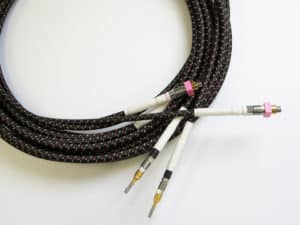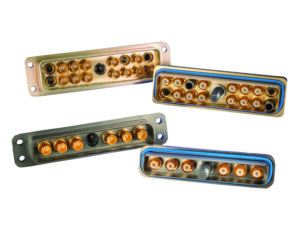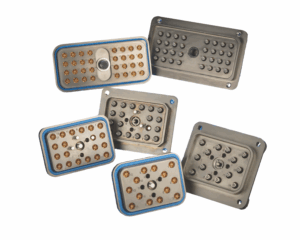Next-Gen RF Connectivity: The Rise of High-Density Multiport Connectors in Military and Avionics
By Matthew Radicchi
Originally published with Microwave Journal
As military and avionics systems continue to evolve, the demand for higher frequencies and greater density within smaller spaces is driving a major shift in RF interconnect technology. Modern aircraft and defense systems require components that are smaller, lighter, and more capable of supporting these increasingly high frequencies—all while maintaining optimal performance in extreme environments. At the same time, avionics platforms are being pushed to the limits, with airframes now supporting not just a dozen antennas, but sometimes hundreds of antenna elements. As signal paths multiply and systems push into millimeter-wave frequencies beyond 30 GHz, traditional connectors are no longer sufficient. They present size, weight, and installation challenges in modern mission-critical environments operating in the microwave frequency range. This makes the demand for rugged, scalable interconnects urgent to support today’s high-performance defense technologies..
To meet these growing demands—especially in electronic warfare (EW), radar, surveillance, and countermeasure systems—multiport connectors have emerged as a compact, lightweight, and high-performance alternative. These systems play a vital role in defense and situational awareness, where real-time data transmission, signal integrity, and system reliability are non-negotiable. Multiport connectors offer improved EMI/EMC shielding, reduce installation errors, and simplify maintenance—critical factors as platforms become more modular and operate at higher frequencies.
Addressing the SWaP Demands of Modern RF Systems
Rising operating frequencies and stringent space requirements drive the ever-evolving RF interconnect requirements across mission-critical systems in avionics and space industries. These systems demand high-density, miniaturized connectors that maintain excellent signal integrity and reliability in extreme environments. A key design consideration in this evolution is SWaP—Size, Weight, and Power—a framework that focuses on components that are physically smaller, lighter, and more energy-efficient without sacrificing performance. RF components must meet these requirements by delivering high performance in smaller, lighter, and more power-efficient formats, all while maintaining reliability in harsh, mission-critical environments.
 The focus on SWaP is driven by the need to optimize today’s airframe systems. Smaller and lighter components reduce overall system weight, enabling increased payload capacity, longer mission durations, and improved platform agility. These essential components must meet complex electrical requirements such as low signal loss and precise impedance matching, along with stringent mechanical requirements for shock, vibration, and thermal cycling. Additionally, they must
The focus on SWaP is driven by the need to optimize today’s airframe systems. Smaller and lighter components reduce overall system weight, enabling increased payload capacity, longer mission durations, and improved platform agility. These essential components must meet complex electrical requirements such as low signal loss and precise impedance matching, along with stringent mechanical requirements for shock, vibration, and thermal cycling. Additionally, they must
perform reliably in extreme environmental conditions, ranging from high-altitude temperature variations to EMI exposure.
Evolution Toward Lightweight Solutions
 The growing emphasis on SWaP optimization has already transformed coaxial cable design, as demonstrated by Times Microwave Systems’ evolution from MilTech® to MilTech Light-Weight assemblies. Originally designed for extreme durability and electrical performance, MilTech cables set the standard for ruggedized RF interconnects. Yet, in applications like aerospace where every gram counts, the shift to MilTech Light-Weight provided a crucial weight savings—without compromising signal integrity or environmental resilience.
The growing emphasis on SWaP optimization has already transformed coaxial cable design, as demonstrated by Times Microwave Systems’ evolution from MilTech® to MilTech Light-Weight assemblies. Originally designed for extreme durability and electrical performance, MilTech cables set the standard for ruggedized RF interconnects. Yet, in applications like aerospace where every gram counts, the shift to MilTech Light-Weight provided a crucial weight savings—without compromising signal integrity or environmental resilience.
This same progression must occur with connectors. By transitioning from traditional connectors to advanced solutions, system designers can achieve the performance required for high-frequency applications while maintaining reliable electrical and mechanical connections in tight spaces. This evolution illustrates how connector technology must advance alongside the systems it supports, providing the lightweight and small form factors essential to meet the high-density requirements of modern airframes and avionics systems.
The Growing Limitations of Traditional RF Connectors in Modern Systems
Traditional RF connectors, such as threaded designs, have served reliably for decades across a wide range of military and aerospace applications. Their proven durability and mechanical stability continue to make them a strong choice in many scenarios. However, as defense and avionics systems evolve to operate at higher frequencies while simultaneously shrinking in size, these legacy connectors are increasingly pushed beyond their original design limits.
Operating at high frequencies introduces a number of signal integrity challenges. Shorter wavelengths place greater demands on connector design to maintain signal integrity, meaning tight dimensional tolerances to minimize reflections and losses. While impedance mismatches may have little impact at lower frequencies, they become more detrimental as frequencies rise, where even minor imperfections represent a larger proportion of the signal’s wavelength. Signal attenuation—or insertion loss—also increases at higher frequencies due to the skin effect, which causes current to concentrate near the surface of the conductor. This results in higher resistance and greater energy loss along the transmission path.
Beyond electrical limitations, traditional connectors also pose mechanical and integration challenges in high-density environments. Threaded coupling mechanisms, though secure, require manual engagement for each connection. In systems with dozens or even hundreds of interconnects, this can lead to longer installation times, increased maintenance complexity, and a higher risk of misconnection—especially when connectors appear visually similar. Additionally, the physical footprint and cumulative weight of multiple threaded connectors can become a significant barrier to meeting modern SWaP requirements.
As next-generation military and avionics platforms continue to increase in complexity—supporting more antennas, sensors, and data paths—while also targeting frequency ranges approaching 40 GHz, the limitations of traditional RF connectors become more apparent. In these environments, advanced connector technologies offer compelling advantages by delivering improved electrical performance, reduced size and weight, and simplified installation—making them better suited to the high-frequency, high-density demands of modern mission-critical systems.
Multiport Connectors: Key to Modern Avionics
Multiport connectors are transforming high-frequency RF interconnects by enhancing EMI shielding, reducing installation complexity, and optimizing space. With applications ranging from fighter jets to UAVs, these connectors enable smaller, lighter, and more resilient avionics systems.
A single multiport connector consolidates multiple connections into one unit, reducing space needed and contributing to a more compact system design. Fewer individual connectors contributes to weight savings and reduces installation complexity. Users can mate multiple cable assemblies at once instead of threading individual connectors on each cable while still maintaining key performance characteristics like vibration handling.
Other key considerations for connectors in these environments include:
- Lightweight: Advances in fuel efficiency rely heavily on weight reduction, and the evolution of frequency band requirements is pushing the development of increasingly lightweight, small, and high-precision RF technologies.
- High density: The increase of antenna arrays in military avionics necessitate a corresponding increase in electronic box deployments and interconnections, concurrent with the rise in operating frequencies and resultant reduction in wavelength to demand advanced, high-density interconnect technologies.
- Shock and vibration: Microphonic noise, arising from vibrational movement in airborne antenna connectors, can severely impact RF signal integrity. Achieving robust performance requires minimizing cable-connector clearances to enhance vibration resilience, with spring-loaded interfaces providing a practical solution to reduce noise and prevent contact plating degradation, thereby improving both electrical and mechanical characteristics.
- Temperature: Higher temperature requirements stem from higher altitudes, speeds, and frequencies, and make material considerations more complex.
Maintenance and access: Aircraft exterior antennas are susceptible to damage, demanding quick repairs; unfortunately, their accessibility within avionics systems is often poor, leading to complex and lengthy maintenance.
Overcoming Connectivity Challenges with Times Microwave’s Multiport Solutions
To address these mounting challenges, Times Microwave Systems developed the M8™ Multiport Connector System, replacing threaded connectors with a spring-loaded push-on connection.
Multiport connectors like the M8 offer a compact alternative to bulky threaded connectors, enabling higher cable density and reducing size and weight to meet SWaP goals. Keyed configurations improve installation accuracy and prevent misconnection. Designed for high-vibration environments, they deliver reliable performance with enhanced EMI-EMC shielding. Unlike traditional connectors, they also support coax, fiber, and octo-contact options—making them a versatile solution for modern systems.
The evolution from M8 to V8, P8, and Mini-Multiport reflects ongoing innovation in modular RF technology, with newer variants engineered to address specific application challenges while ensuring mission-critical performance in demanding environments.
M8 Multiport Connector System: The Foundation
 The original M8 multiport connector system established the core advantages that would define the multiport approach. It delivered high-frequency performance, supporting frequencies up to 20 GHz with low insertion loss and excellent shielding. The system maintained superior phase stability even in extreme environments, with channel isolation exceeding 100 dB to minimize EMI and crosstalk. It also provided support for phase-matched and equalized assemblies, reducing cable routing complexity. Environmental resilience was achieved through lightweight aluminum construction that enhanced durability. The REACH/RoHS-compliant conductive plating provided 2,000 hours of salt fog resistance and 668 hours of sulfur dioxide resistance, ensuring excellent performance in both airborne and maritime applications.
The original M8 multiport connector system established the core advantages that would define the multiport approach. It delivered high-frequency performance, supporting frequencies up to 20 GHz with low insertion loss and excellent shielding. The system maintained superior phase stability even in extreme environments, with channel isolation exceeding 100 dB to minimize EMI and crosstalk. It also provided support for phase-matched and equalized assemblies, reducing cable routing complexity. Environmental resilience was achieved through lightweight aluminum construction that enhanced durability. The REACH/RoHS-compliant conductive plating provided 2,000 hours of salt fog resistance and 668 hours of sulfur dioxide resistance, ensuring excellent performance in both airborne and maritime applications.
The M8 system delivered significant size reduction by eliminating bulky threaded connectors, substantially reducing the physical footprint required for multiple RF connections. Its compact design enabled higher cable density, integrating multiple RF paths into a single connector footprint and maximizing space efficiency. The keyed configurations improved installation accuracy by eliminating misconnection risks, significantly reducing the potential for costly wiring errors.
The M8 system quickly established itself as the go-to solution for critical platforms including the F-15, F-18, P8, and V22, collectively logging hundreds of thousands of flight hours.
V8 Multiport Connector: Enhanced Vibration Resistance
As aircraft designs evolved to become faster, more agile, and incorporated more onboard systems, interconnect solutions required smaller, lighter, and more vibration-resistant connectors. Building on the legacy of the M8, Times Microwave Systems developed the V8 multiport connector. Key features of this variation include an improved spring-finger mechanism for increased stability and titanium construction to reduce weight and enhance corrosion resistance, all to meet the high-vibration requirements for next-gen aircraft. The design also incorporates lower insertion force for easier installation. The V8 became the preferred solution for advanced platforms including the F-35 and newer F-15 variants, where vibration performance was particularly critical.
P8 Multiport Connector: Skin Penetration Applications
The success of the multiport concept led to customer demand for extending the technology to specialized applications. One key challenge was developing a connector that could effectively penetrate the aircraft skin for external systems—the P8 design was created specifically for this purpose. It features a unique locking mechanism enabling one-man, one-side installation and is optimized for extreme environmental conditions, including high altitudes and temperature fluctuations. The P8 variant has been successfully deployed on platforms including the P8 Poseidon, E2/E2D, and E7 Wedgetail, where its specialized capabilities provide critical advantages.
Mini Multiport Connector (MMP) System: Higher Density, Higher Frequency
 Building upon the legacy of high-density, low weight, and easy installation, the next generation of multiport is called the Mini-Multiport (MMP). The initial design was inspired by the MIl-DTL-38999 specification with a front release feature. The MMP system extends operating frequency to 40 GHz and features a rectangular design enabling custom footprint optimization. It provides even higher density with smaller contact diameters and offers direct PCB mount compatibility. Designed for modular scalability, the MMP allows integration with additional system components.
Building upon the legacy of high-density, low weight, and easy installation, the next generation of multiport is called the Mini-Multiport (MMP). The initial design was inspired by the MIl-DTL-38999 specification with a front release feature. The MMP system extends operating frequency to 40 GHz and features a rectangular design enabling custom footprint optimization. It provides even higher density with smaller contact diameters and offers direct PCB mount compatibility. Designed for modular scalability, the MMP allows integration with additional system components.
The Future of High-Frequency RF Interconnects
Today, tens of thousands of multiport solutions serve on mission-critical platforms, with hundreds of thousands of flight hours logged in the most demanding environments—from supersonic fighters to naval aircraft. These compact, rugged connectors have redefined RF interconnects by enhancing EMI shielding, simplifying installation, and maximizing space efficiency.
As military and aerospace systems push for smaller, lighter, and higher-performing components, traditional connectors can no longer meet modern SWaP, frequency, and reliability demands. Multiport connector solutions—like the M8, V8, P8, and Mini-Multiport—have emerged as essential enablers of next-generation performance, offering a compact, rugged, and scalable approach to RF connectivity. By simplifying installation, improving signal integrity, and withstanding harsh environmental conditions, these connectors help defense and aerospace platforms maintain peak operational readiness and performance.
With over three decades of innovation, Times Microwave Systems continues to lead the way in high-frequency RF connectivity, delivering reliable, future-ready solutions that keep defense and aerospace platforms operating at peak performance.
MilTech® is a registered trademark of Times Microwave Systems. M8™ is a trademark of Times Microwave Systems.
Subscribe to our newsletter!
Interested in receiving email newsletters and other updates from Times? Subscribe now!
